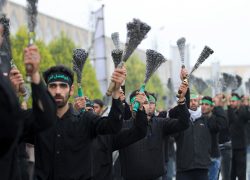Elahe Jalali
Translator
Published posts

Yalda: A Night of Fire and Tradition
Yalda is one of the ancient Iranian celebrations, and the word “celebration” itself originates from the term “Yasan”, which refers to religious and ritual practices. Yalda symbolizes the birth of the sun. But the question arises: why should the blazing sun be born in the midst of the coldest season, and what is the connection between the birth of light and the darkest and longest night of the year?

Haj Abbas Nilforushan
Martyr Abbas Has Returned Home
When Haj Ali Zahedi was martyred, it was essential to quickly introduce a replacement. The choice was Haj Abbas Nilforushan, who was a close companion, partner, and support of Seyed Hassan Nasrollah. When the Supreme Leader said, “Whatever Seyed Hassan Nasrollah’s opinion is,” Haj Abbas replied, “It is the command of the Master. I must go,” and he went. The lump in his throat gives weight to the beautiful words he speaks with his Isfahani accent as he says, “Since I was six years old, I have wished to destroy Israel.” He was hopeful for martyrdom in this cause, which was granted through God’s grace.

We finally reached the closing ceremony...
We Are Strangers No More!
The 36th International Film Festival for Children and Youth, with all its ups and downs, came to an end on Friday with a closing ceremony. There’s much to discuss about the 36th edition and its events, but let’s leave those conversations for another time. This piece, however, focuses on a different subject.

Persian Carpets: A Tapestry of Art and Mysticism
The challenges facing Iranian carpets today are fundamental issues requiring the insight and solutions of art experts, carpet specialists, and industry professionals. However, the Persian carpet—an art form whose origins, according to historians, lie with the nomadic and rural people of this land—boasts a rich and golden history. Particularly in the Safavid era of Isfahan, it reached unparalleled refinement and perfection.

He was a teacher, a calligrapher, and a religious scholar
Ink and Faith: Fazaeli’s Eternal Art
He was a teacher, a calligrapher, and a religious scholar. His hand was immersed in the fire of calligraphy, and his pen case was as vast as his passion for writing, leaving behind works that became his legacy. These legacies can sometimes be found adorning the courtyards of village sanctuaries, mosques, and hussainiyas in towns and cities, bearing the signature of Habibollah Fazaeli Semiromi.

I often feel that schools don't fully understand the challenges we working mothers face
Does the School Consider Mothers?
As a working mother, whenever my child’s school invites me to attend meetings, I always worry about how I can fit it into my already packed schedule. With household chores, caring for other children, and my job, finding time for these meetings is really challenging.

How did Rehnan’s hammams achieve improved sanitation?
The Evolution of Hygiene in Rehnan’s Hammams
In Qajar-era Iran, there were no established institutions for health and hygiene. Only the Municipality, which had existed since the Constitutional Revolution, had a department called “Health Preservation” that was responsible for the city’s health and medical affairs.

Kaveh Terminal
Modern, Yet in Isfahan’s Hue!
In late 1988, to organize the city’s terminals and garages, Kaveh Terminal, followed by Soffeh, Jey, Samadiyeh, and ZayandehRood terminals, were constructed in Isfahan.

Working at the newspaper didn’t keep me from my home life
Passionate Soul
All I can remember from my teenage years and early twenties is running around town. I had just learned how to get around on my own, taking buses and taxis wherever the wind took me. If there was somewhere a young girl might find something interesting, I was probably there. And when I moved away for college, it was more of the same.

For days, Isfahan has been adorned with the phrase "24,000 and Me," a testament to the upcoming event that has captured the city's attention
The National Congress of 24000 Martyrs of Isfahan
For days, Isfahan has been adorned with the phrase “24,000 and Me,” a testament to the upcoming event that has captured the city’s attention. Making my way to The Isfahan Musalla. As I turned onto Ayatollah Khansari Street, I was greeted by a heartwarming sight: volunteers eagerly assisting those in need, pushing wheelchairs and offering a helping hand. Every few steps, a new stall beckoned, each a testament to the community’s involvement.

Bilal ibn Rabah was among the first to embrace Islam and served as the Prophet Muhammad's first muezzin
Unwavering Faith
Bilal ibn Rabah was among the first to embrace Islam and served as the Prophet Muhammad’s first muezzin. Little is known about his life before his conversion, but upon embracing Islam, he faced severe torture and persecution from his enemies.

Alireza Zakeri's actions exemplify the art of resistance in practice
A hard choice, but the right one
For some time now, we have been introducing the art of resistance artists from around the world in this section – individuals who have used their art to amplify the voice of Palestine and the resistance movement. Today, while browsing through social media for a new subject, I stumbled upon the portrait of a young Iranian man named Alireza Zakeri, a gold medalist in the computer olympiad and a graduate of Sharif University and the University of British Columbia in Canada.






